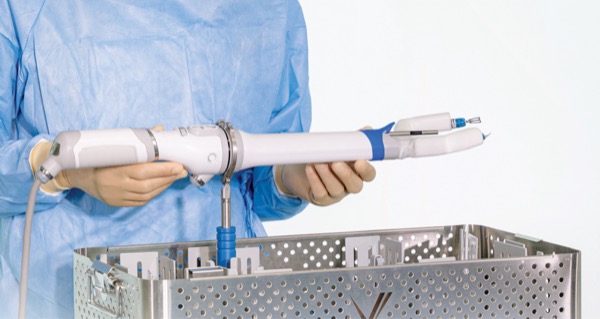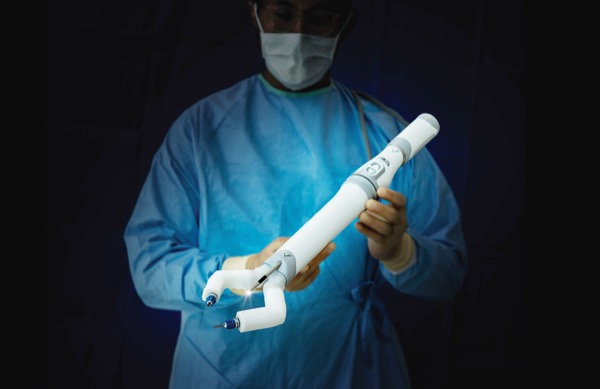When OR Management News first reported on the miniaturized in vivo robotic assistant (MIRA) surgical system developed by Virtual Incision in January 2021, the company was working toward FDA approval for an investigational device exemption trial. Since then, the company has been busy investigating and refining its devices and has been granted FDA authorization to market MIRA for use in adults undergoing colorectal procedures.
The authorization, based partly on the findings of a recent clinical investigation, was done through the FDA’s relatively new De Novo process, as MIRA belongs in a heretofore un-predicated category: miniature robotic-assisted surgery (miniRAS) devices.
“There are a number of mainframe systems, which require docking and have big external robotic arms. We’ve done the opposite. We’ve made MIRA small with our robotic arms going into the patient. That allows us to do robotics in a very different way,” said Dmitry Oleynikov, MD, a co-founder and the chief surgeon of Virtual Incision.
Unlike conventional robotic-assisted platforms, which require a dedicated OR, the diminutive MIRA minibot, weighing approximately 2 pounds, is carried into the OR in a tray. About the size of a human forearm at 2 feet long, the minibot fits into a patient’s abdomen through a single small abdominal incision; procedures are performed by a surgeon working from a console with the aid of an assistant. The minibot and camera can be reused up to 15 times after sterilization.
In addition to providing a complementary and alternative option in centers that currently have robotic-assisted surgery platforms, Dr. Oleynikov anticipates the surgical system’s size and portability will introduce robotic-assisted surgery to places too remote or too small to accommodate standard surgical platforms. Since Dr. Oleynikov and Shane Farritor, MS, PhD, a fellow co-founder of Virtual Incision, met in 2001, they’d been thinking about the types of places where a minibot would be useful.
“There has been a lot of experimental work. We worked with the Department of Defense to put robots into submarines, and with NASA to investigate robotic devices in space,” Dr. Oleynikov said.
This experiment in simulated surgery, conducted aboard the International Space Station earlier this year, was the work of Dr. Farritor and a doctoral student, Rachael Wagner, to observe how a customized MIRA—spaceMIRA is slightly shorter than standard MIRA—performs in space, operating in both preprogrammed and remote surgery modes.
“We were looking for how it would work, whether we could control it from Earth, how much delay there is and how we will manage those delays,” Dr. Oleynikov said. “It was a well-crafted experiment. spaceMIRA is on its way back, and we’ll be able to get some scientific background behind that event.”
For the time being, MIRA has shown its muster in earthly ORs. Data gathered from the clinical trial investigating the device in 30 patients undergoing colorectal procedures and one-year cancer outcomes were recently presented at the 2024 annual meeting of the Society of American Gastrointestinal and Endoscopic Surgeons. Investigator Michael A. Jobst, MD, a colon and rectal surgeon at Surgical Associates PC, in Lincoln, Neb., who performed half of those procedures, said the trial was a success.
“On average, patients went home two to two-and-a-half days after surgery. Some patients were really excited to be part of this development of a new technology. But what really matters is they were all pleased with their procedures. On average, my patients had prompt return of bowel function and prompt return to normal, everyday activities,” Dr. Jobst said.
“From the surgeon’s point of view, there are some differences between standard robotic-assisted surgery platforms and the use of a miniaturized platform. For starters, the console is open and the surgeon is seated upright with full visualization of the OR,” he said.
“I think this design allows for better communication between the surgeon and OR team and gives you a better sense of what’s happening in the OR.”
“Manipulation of the controls is also a bit different. With standard robotic-assisted surgery platforms, triangulation of instruments occurs outside the body; with MIRA, triangulation is internal,” Dr. Jobst said.
“What the minibot sees and what the arms do are very tucked into each other. As the minibot moves from one side to the other, you have much greater freedom to work and you can operate in all four quadrants of the abdomen.”
Virtual Incision has started marketing MIRA to selected centers in the United States through its First Access Program, focusing on centers with expertise in complex surgery and expanding to more sites over time.
This article is from the May 2024 print issue.



